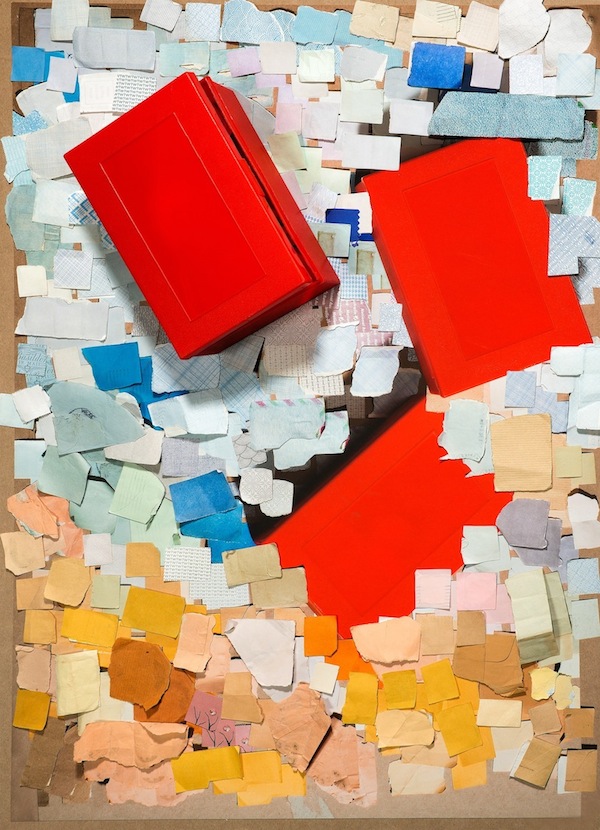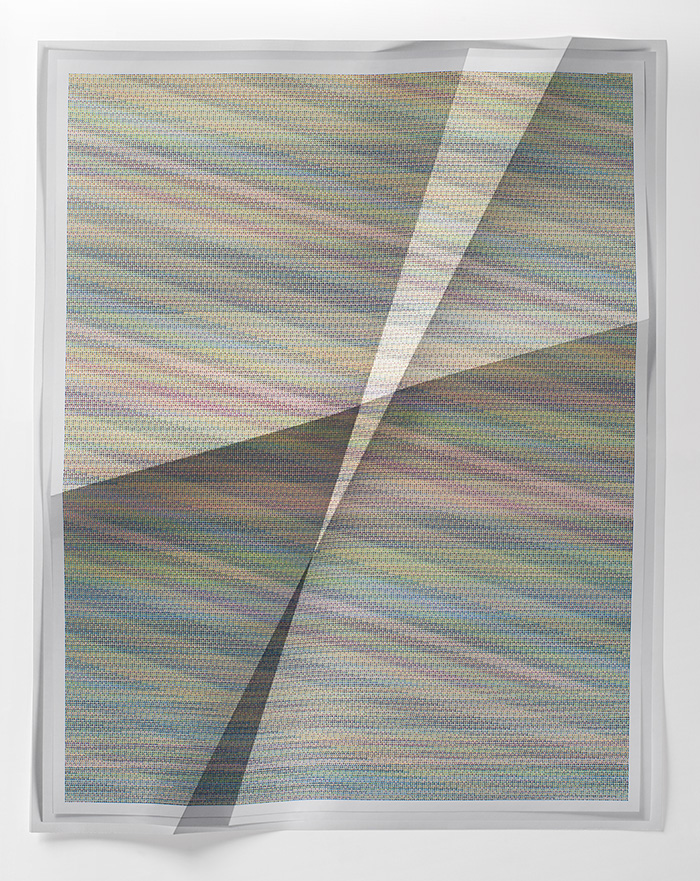
© » KADIST
Firenze Lai
Central Station, Alignment, and Sumo are “situation portraits” that present whimsical characters within distorted and troubling worlds. These portraits explore the relationship between the psyche and contemporary social environments, focusing on isolation, identity, and distress. Central Station shows a character reaching to wipe a tear from her face as the blues of her wardrobe seem to blend in with the dismal blue of the background.

© » KADIST
Firenze Lai
Central Station, Alignment, and Argument are “situation portraits” that present whimsical characters within distorted and troubling worlds. These portraits explore the relationship between the psyche and contemporary social environments, focusing on isolation, identity, and distress. The two characters in Argument interact in an ambiguous gesture of conflict or embrace as the world around them pulsates in agitated waves.

© » KADIST
Firenze Lai
Central Station, Alignment, and Sumo are “situation portraits” that present whimsical characters within distorted and troubling worlds. These portraits explore the relationship between the psyche and contemporary social environments, focusing on isolation, identity, and distress. The figure in Alignment slouches with his head in his hands in a gesture of failure or despair, speaking to the difficult task of balancing individual freedom and societal rules.

© » KADIST
Elisheva Biernoff
Drawing & Print (Drawing & Print)
Last Postcards is a series of three small double-sided paintings on plywood in which Biernoff imagines the last communications from explorers lost in the wilderness. Biernoff’s choice of Everett Ruess, Percy Fawcett, and the conceptual artist Bas Jan Ader is particularly telling. On one level, the Last Postcards analogize the nineteenth-century explorer with the contemporary artist who looks for purpose in their work.

© » KADIST
Conrad Ruiz
It may take a minute to recognize the background of New Fall Lineup – the colors are tweaked into a world of cartoon and candy, and it is covered by leaping energetic figures and flying squirrels. One realizes, though, that the image is of the World Trade Center exploding into flame, creating a strange contrast with the painting’s colors and the other images. The combination is peculiar because the role the explosion serves here is non-specific.

© » KADIST
Conrad Ruiz
Conrad Ruiz loves to paint subjects related to the “boy zone”: video games, weapons, games, science fiction, fantasy, and special effects. He also often works at a very large scale to emphasize a connection to the tradition of history painting. Blockbuster (2011) was, at the time of its creation, the largest watercolor painting he had ever made.

© » KADIST
Nathaniel Dorsky
Dorsky’s pieces included in the Kadist Collection are small still photographs from twelve of his most important films. Here, the still images function in the same way as his cinematographic work: Highly aesthetic, they allow for the appearance of intricate visual patterns and layers of meaning that take scenes of everyday life as its source material. Both Dorsky’s cinematic and photographic works follow a stream of consciousness that rejects representation or fixed narrative structure.

© » KADIST
Luke Butler
Drawing & Print (Drawing & Print)
In Captain X , Star Trek’s Captain Kirk, played by William Shatner, is limply draped over a large boulder in what looks like a hostile alien environment. However, Kirk’s passive pose doesn’t so much suggest the aftermath of a battle as it does heavy contemplation, depression, or utter despair. Captain X is part of a series of paintings depicting various Star Trek characters who are stricken with human emotion-—a tactic that diminishes the mythological grandeur associated with this heroic captain and his indefatigable crew.

© » KADIST
John Houck
Baby Shoes, Never Worn is part of photographer John Houck’s series of restrained still-life photographs capturing objects from his childhood. The image depicts a box, addressed to the artist’s mother, that once contained—it can be assumed—baby shoes. Houck layers the photograph with multiple exposures, lending an uneasy tripling effect to the static object.

© » KADIST
John Houck
John Houck’s brown- , sienna- and golden-toned composition, Untitled #185, 65, 535 combinations of a 2×2 grid, 16 colors , features densely packed lines of color moving diagonally across the creased page. Houck uses a series of self-designed software programs to create these intricate grids of color and line, riffing off of Sol LeWitt, perhaps, in a digital age. Houck takes the output of these programs and then manipulates them manually, creasing the pages of the index print, and then re-photographing them.

© » KADIST
John Houck
John Houck’s multi-layered photographic compositions immortalize nostalgic objects from the artist’s childhood, manipulated in the studio and in post-production into unreal still-life arrangements. Stamp -X, Stamp -Y consists of a careful collage of uneven scraps of paper. On their versos, these fragments of blue, white, and manila papers hold the artist’s childhood stamp collection; turned as they are, these shards of envelope become planes of colors that Houck manipulates in a vaguely grid-like fashion.

© » KADIST
Ana Teresa Fernández
Drawing & Print (Drawing & Print)
The artist writes about her work Borrando la Frontera, a performance done at Tijuana/San Diego border: “I visually erased the train rails that serve as a divider between the US and Mexico. I painted them sky blue, creating a “Hole in the Wall” This deconstruction of “feminized” work explores the difficulties in reconciling both low wages and undervalued work via social and political infrastructures, confronting issues of labor and power. The images that I myself perform, present a duality: women dressed in a black tango dance attire while engaging in de-skilled domestic chores; the surreal within non-fiction.

© » KADIST
Kori Newkirk
LAB (2013) conjures the body as the trace of a sooty hand appears, spectrally, on a crumpled paper towel. His photograph of this throwaway object calls back the body, and the handprint is in fact his own right hand; thus the piece can function as a self-portrait of the artist, in an ironic twist on the art historical genre.

© » KADIST
Elisheva Biernoff
In her recent work, Biernoff is interested in investigating fictions and fantasies embedded in the remnants of consumer culture (for example magazines) or through ephemera such as postcards and old photographs. Although the imagery present in her work might seem nostalgic upon first encounter, Biernoff’s complex tableaux often reveal the artist’s skeptical look towards her subjects matters. They Were Here (2010), constitutes a clear example.

© » KADIST
Kan Xuan
In Kan Xuan’s four-channel video Island , a series of objects like nail clippers, hairbrush, toothpaste, and house decorations are shot in close-ups. These highly polished and aestheticized images create a poetic visual flow. However, in front of each object lies a coin of different value—two yuan, one pound, one euro, one dollar—that silently reveals the material value of the household supplies.

© » KADIST
John Houck
Houck’s Peg and John was made as part of a series of photographic works that capture objects from the artist’s childhood. In this image, drafting materials (pencils, compasses, and protractors) are laid out next to shotgun shell casings. Presenting these objects in juxtaposition but without commentary, Houck offers a partial but interesting glimpse into his own biography.

© » KADIST
Yao Jui-Chung
Long Long Live (2013) takes the viewer to the setting of the Oasis Villa on Green Island, once a reform and re-education prison to house political prisoners during Taiwan’s martial law period. In black and white, Yao depicts the historical site as an eerie abandoned compound. Reflecting on the centenary of the HsinHai Revolution and the end of the Cold War, Yao questions the existence of an ever lasting dynasty or “transcendental Rules of History.” The soundtrack features a sole voice reverberating through loud speakers.

© » KADIST
John Houck
Untitled #242 is part of Houck’s Aggregates Series, which uses digital tools to manipulate chosen sets and pairs of colors, creating colorful index sheets, bathed in colors and lines. Houck transforms these simple outputs physically, folding, lighting, photographing, and re-printing them, only to fold, photograph, and re-print again. An MFA graduate from UCLA, John Houck works primarily in the medium of photography and specializes in still-life vignettes.
John Houck
- year born: 1977
- gender: male
- nationality: American
- home town: South Dakota
Firenze Lai
Firenze Lai is a Hong Kong painter known for her atmospheric portraits that explore the ways in which contemporary life causes people to adjust to their surrounding conditions in disturbing ways...
Conrad Ruiz
Conrad Ruiz makes watercolor paintings of fantastic scenes...
Yao Jui-Chung
- year born: 1969
- gender: male
- nationality: Taiwanese
- home town: Taipei, Taiwan
Nathaniel Dorsky
Nathaniel Dorsky belongs to a younger generation of filmmakers that follows key figures of the Bay Area avant-garde scene, like Bruce Conner, and is mainly associated with Canyon Cinema...
Luke Butler
- location: San Francisco, California
- year born: 1971
- gender: male
- nationality: American
- home town: New York, New York
-
2000-2009
Luke Butler
Drawing & Print
2008(Drawing & Print) In Captain X , Star Trek’s Captain Kirk, played by William Shatner, is limply draped over a large boulder in what looks like a hostile alien environment...
Elisheva Biernoff
Drawing & Print
2009(Drawing & Print) Last Postcards is a series of three small double-sided paintings on plywood in which Biernoff imagines the last communications from explorers lost in the wilderness...
Conrad Ruiz
2009It may take a minute to recognize the background of New Fall Lineup – the colors are tweaked into a world of cartoon and candy, and it is covered by leaping energetic figures and flying squirrels...
Elisheva Biernoff
2009In her recent work, Biernoff is interested in investigating fictions and fantasies embedded in the remnants of consumer culture (for example magazines) or through ephemera such as postcards and old photographs...
-
2010-2019
Nathaniel Dorsky
2010Dorsky’s pieces included in the Kadist Collection are small still photographs from twelve of his most important films...
Conrad Ruiz
2011Conrad Ruiz loves to paint subjects related to the “boy zone”: video games, weapons, games, science fiction, fantasy, and special effects...
Ana Teresa Fernández
Drawing & Print
2011(Drawing & Print) The artist writes about her work Borrando la Frontera, a performance done at Tijuana/San Diego border: “I visually erased the train rails that serve as a divider between the US and Mexico...
Firenze Lai
2013Central Station, Alignment, and Sumo are “situation portraits” that present whimsical characters within distorted and troubling worlds...
Firenze Lai
2013Central Station, Alignment, and Argument are “situation portraits” that present whimsical characters within distorted and troubling worlds...
Firenze Lai
2013Central Station, Alignment, and Sumo are “situation portraits” that present whimsical characters within distorted and troubling worlds...
John Houck
2013Baby Shoes, Never Worn is part of photographer John Houck’s series of restrained still-life photographs capturing objects from his childhood...
John Houck
2013John Houck’s brown- , sienna- and golden-toned composition, Untitled #185, 65, 535 combinations of a 2×2 grid, 16 colors , features densely packed lines of color moving diagonally across the creased page...
John Houck
2013John Houck’s multi-layered photographic compositions immortalize nostalgic objects from the artist’s childhood, manipulated in the studio and in post-production into unreal still-life arrangements...
Kori Newkirk
2013LAB (2013) conjures the body as the trace of a sooty hand appears, spectrally, on a crumpled paper towel...
John Houck
2013Houck’s Peg and John was made as part of a series of photographic works that capture objects from the artist’s childhood...
Yao Jui-Chung
2013Long Long Live (2013) takes the viewer to the setting of the Oasis Villa on Green Island, once a reform and re-education prison to house political prisoners during Taiwan’s martial law period...
John Houck
2013Untitled #242 is part of Houck’s Aggregates Series, which uses digital tools to manipulate chosen sets and pairs of colors, creating colorful index sheets, bathed in colors and lines...
